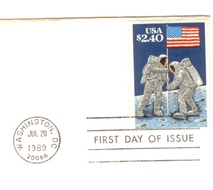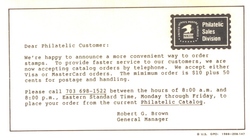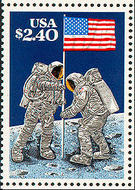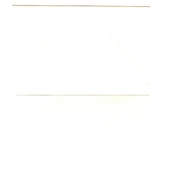US // Apollo 11 / 20th Anniversary Stamp
The $2.40 20th Anniversary Priority Mail Stamp of 1989
In issuing its first Priority Mail stamp on July 20, 1989, the United States Postal Service achieved two objectives. It promoted Priority Mail service, which promised two-day delivery between all major markets and three-day delivery elsewhere. And it celebrated the 20th Anniversary of the Apollo 11 voyage to the Moon.
The denomination of the stamp was $2.40, the rate then in effect for Priority Mail items weighing from 12 ounces to two pounds. It was dedicated at the National Air and Space Museum in Washington, in conjunction with a major federal observance of the Moon-landing Anniversary.
The U.S. Postal Service had been considering a special stamp for Priority Mail for some time. At one point, officials asked Chuck Ripper of Huntington, West Virginia, a wildlife artist who had designed numerous stamps in the past, including the 50-stamp American Wildlife pane of 1987, to prepare some concept sketches. But Ripper's finished artwork - a painting of a pheasant in flight - ended up not on a Priority Mail stamp but squeezed into a small format and used on a 25-cent definitive in booklets.
When the time came to issue the first Priority Mail stamp, space, not wildlife, was the theme. The stamp would be the Postal Service's first on a space topic since 1981. Space had been the subject of numerous U.S. stamps in the 1970s, in the afterglow of the successful Apollo flights, but the troubles that befell NASA in the 1980s - especially the tragic loss of the space shuttle Challenger in 1986 - gave the United States little to commemorate postally during that decade.
Postal commemoration of a 20th Anniversary actually was contrary to Citizens' Stamp Advisory Committee policy. Item No. 4 of CSAC's subject selection criteria reads: "Events of historical significance shall be considered for commemoration only on Anniversaries in multiples of 50 years." However, as postal officials explained it, the Moon landing was an event of such historic significance that the committee agreed to waive the rule.
Selecting Chris Calle to design the stamp was largely the idea of Jack Williams of the Postal Service's stamp design section, who had been assigned to be manager and art director for the Priority Mail project. Williams thought it would be fitting that the son of the designer of the original Moon Landing stamp should design the stamp commemorating its 20th Anniversary. He knew, too, as he confided, that Paul would inevitably "be peeking over Chris's shoulder."
Chris welcomed Paul's advice, but he was an established artist in his own right. He lived in Ridgefield, Connecticut, a few miles from Paul's home in Stamford, and the two shared a studio. As a boy, his father's work and achievements had stimulated Chris's own fascination with art. He became a freelance illustrator after graduating with honors from the University of Michigan in 1983. Besides receiving many major commissions from magazines and corporations, Chris followed in Paul's footsteps by being named an official NASA artist documenting the Space Shuttle program.
By 1989 he was already an experienced stamp designer as well, having produced the portraits for eight Great Americans definitive stamps (Harry Truman, John James Audubon, Admiral Chester W. Nimitz, Justice Hugo Black, Belva Ann Lockwood, Father Howard Flanagan, Dr. Paul Dudley White and General "Hap" Arnold) and the images for three Transportation Series definitive coil stamps (wheelchair, tandem bicycle and fire engine). He also had designed the Connecticut Statehood Bicentennial commemorative of 1988.
For the $2.40 Priority Mail stamp job, Chris did extensive research. He combed local libraries for material, and also tapped the most obvious source: his father's extensive file of photographs and drawings made during Apollo training sessions in the 1960s.
One of the early ideas Chris proposed to the Postal Service, in fact, was a "stamp on stamp" design incorporating Paul's original 10- cent Moon Landing stamp of 1969. He prepared a pair of sketches incorporating this concept. The Postal Service rejected that idea, preferring to use original art.
Both Calles make a policy of offering their clients a variety of design treatments. As Paul said: "A lot of artists do just one sketch, and if it's turned down they do another sketch. But Chris has been brought up with the idea that you investigate all the different possibilities; not just one design, but different points of view, and submit it all, as long as you can happily live with whichever one they choose to go with."
Accordingly, Chris sent several concept sketches to the Postal Service. "Dad had some very distinct ideas about some of them," he recalled. "I basically did the sketches, but certainly Dad's influence was behind them."
The Citizens' Stamp Advisory Committee, a panel that recommends stamp subjects and designs to the postmaster general, looked over the submissions and chose a vertical treatment showing the two Apollo 11 astronauts planting the American flag on a cratered lunar surface. Some of Chris's proposed designs included inscriptions calling attention to the 20th Anniversary, but Postal Service officials decided that the stamp should be bare of type except for the basic "USA $2.40."
Chris executed his finished artwork in the "mixed media" he often uses - a combination of colored pencil, colored inks, dyes and gouache (opaque watercolor) or tempera paints. Like Paul Calle's 1969 stamp, this one was assigned to the Bureau of Engraving and Printing for production by offset and intaglio. The Bureau's Kenneth Kipperman engraved the vignette, Dennis Brown engraved the lettering and numerals, and Ronald Sharpe modeled the stamp.
Instead of the two presses that had been needed for combination printing in 1969, however, the Bureau now had a modern high-speed web- fed press capable of handling the job in one pass. It was the Goebel "D" press, which was officially designated Press 902, capable of producing stamps in six offset and three intaglio colors. For this one, five offset colors were actually used - red, yellow, blue, black and dark blue - and one intaglio color, black.
Although the 1969 Moon Landing stamp had been the largest issued up to that time, the Postal Service had produced even bigger stamps since then. One of them was the $8.75 Express Mail stamp of 1988, and the new Priority Mail stamp was formatted to its dimensions: approximately 1 1/4 inches wide by 1 13/16 inches deep. The new stamp was printed from offset plates of 80 subjects and intaglio sleeves of 160 subjects and was issued in post-office panes of 20 stamps.
After Chris Calle turned in his finished artwork, "the Bureau did a beautiful job with it," Jack Williams recalled. Bureau technicians used a computer graphics program, he said, to "smooth out" the dark blue sky Chris had provided as background, making it a uniform solid blue, and to de-emphasize some of the shading lines on the flag "so it wouldn't took as if the flag was soiled or covered with Moon dust."
"Then the engraver (Kenneth Kipperman) did quite a bit of work," Williams added, "etching lines in and around the feet and legs, bringing out the craters a little more sharply, hyping up the highlights in the helmet, and providing a little more gray in the Moon's blue, to make it closer to the actual coloration of the soil."
The ceremony at the National Air and Space Museum July 20, 1989, combined a celebration of the 20th Anniversary of the Moon landing and the dedication of the Priority Mail stamp. It featured an address by President George Bush, and marked his first attendance as president at a stamp first-day event.
The president was introduced by Vice President Dan Quayle. After the stamp was dedicated by Postmaster General Anthony M. Frank, Apollo 11 astronauts Armstrong, Collins and Aldrin each spoke briefly. Both Calles were in attendance.
A total of 208,982 First Day Covers of the stamp were postmarked. Then, in 1994, the Postal Service reported that more than $24.4 million worth of the stamps - more than 10.1 million stamps - had been saved by collectors and others, and likely would never be used for postage. This may reveal the reason why the subject was chosen for the $2.40 Priority Mail Stamp in the first place.
Whereas the 1969 stamp had produced one major error variety - the missing red offset color - the 1989 Priority Mail stamp generated three.
The first to be reported consisted of two full 20-stamp panes that completely lacked the black intaglio ink that provided details of the astronauts' space suits and the lunar surface. Also missing was the single-digit intaglio sleeve number that normally appeared in the selvage adjacent to the four corner stamps on a pane of 20. Small spots of black and blue appeared in the ghostly areas of the design that represented the astronauts' undefined bodies, but these appeared to be spatters of offset ink.
The error stamps were discovered in 1990 by an unidentified collector who bought 10 Priority Mail panes at the Oak Forest station of the Houston, Texas, post office. Upon examination, the collector found the two error panes in the middle of the group. Bob Dumaine of Sam Houston Philatelics of Houston bought both panes from the finder. The variety was assigned the Scott catalogue number 2419a.
Later in 1990, collectors learned of the discovery in California of two full panes and one partial pane of imperforate Priority Mail stamps. Merle Spencer, owner of The Stamp Gallery in Walnut Creek, California, purchased the error stamps from a collector in the San Francisco Bay area. Five stamps from one pane had already been cut and used for postage when the error was recognized. The imperforate variety was listed by Scott as 2419b.
In addition, one pane of 20 of the $2.40 stamp was found with the black offset color missing. This variety received the Scott number 2419c.
Single copies of the missing-intaglio variety were auctioned by Jacques C. Schiff Jr. May 28, 1992, for $2,600, and by Lowell S. Newman & Co. March 13, 1993, for $2,000. A horizontal pair of the imperforate variety, with plate number attached, was auctioned by Schiff at the May 1992 sale for $850.
ZFC Noteworthy Artifact
No Description













